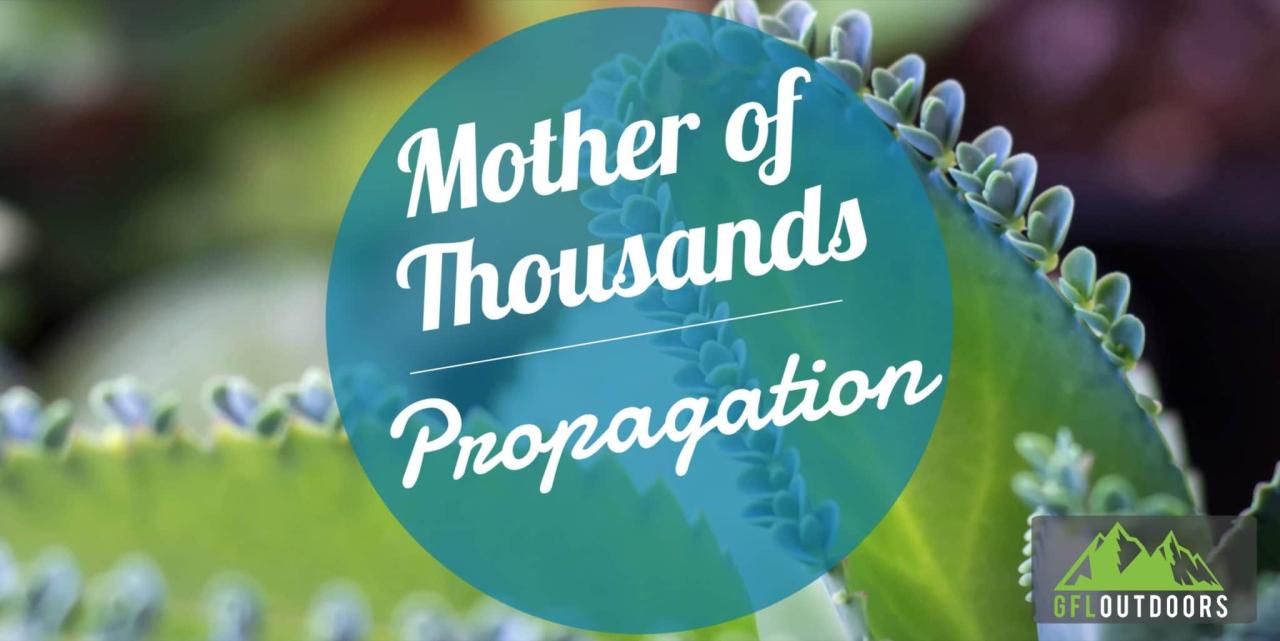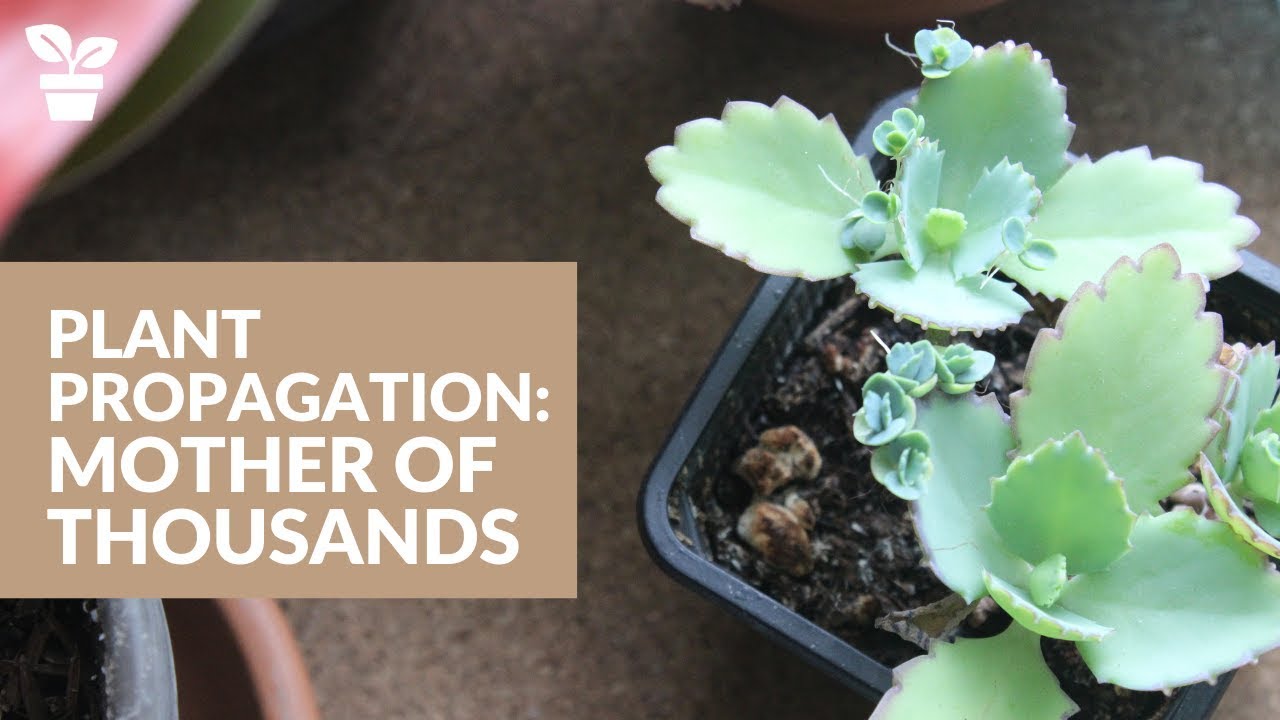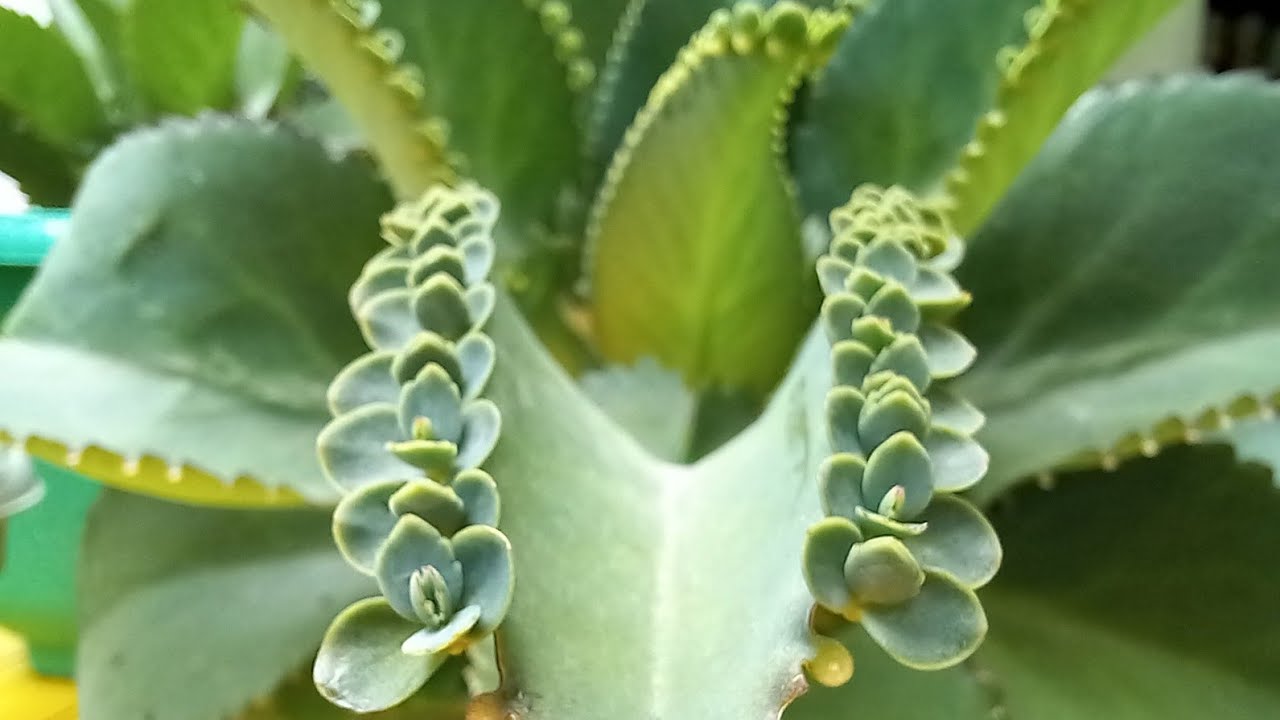The Secrets to Effective and Simple Propagation of Mother of Thousands, a succulent known for its unique ability to produce plantlets along its leaf margins, offers a rewarding experience for plant enthusiasts of all levels. This guide will unveil the secrets to successfully propagating this captivating plant, empowering you to create a thriving colony of Mother of Thousands with ease.
Mother of Thousands, scientifically known as Kalanchoe daigremontiana, is a fascinating succulent that captivates with its ability to produce numerous plantlets along the edges of its leaves. These plantlets, essentially miniature versions of the parent plant, readily detach and take root, making propagation a breeze.
The ease of propagation, coupled with its striking appearance and air-purifying qualities, has made Mother of Thousands a popular choice for both novice and experienced gardeners.
Introduction to Mother of Thousands
Mother of Thousands, scientifically known asKalanchoe daigremontiana*, is a captivating succulent renowned for its unique characteristics and remarkable propagation abilities. Its striking appearance and ease of reproduction make it a popular choice for both novice and experienced gardeners.This succulent’s most distinctive feature is its ability to produce numerous plantlets along the edges of its leaves.
These plantlets, also known as “bulbils,” are miniature versions of the parent plant, complete with roots and leaves, ready to develop into independent plants.
The Benefits of Propagating Mother of Thousands
Propagating Mother of Thousands offers several advantages, making it a desirable plant for both home gardeners and those interested in plant propagation:
- Easy and Efficient Propagation:Mother of Thousands readily produces plantlets, eliminating the need for traditional methods like cuttings or seeds. This makes propagation a simple and efficient process.
- Abundant New Plants:The abundance of plantlets allows for the creation of numerous new plants from a single parent plant. This can be a rewarding experience for gardeners and a great way to share plants with others.
- Low-Maintenance Propagation:Propagation of Mother of Thousands requires minimal effort and resources. The plantlets naturally root and develop into new plants, requiring minimal intervention from the gardener.
- Preservation of Genetic Traits:Propagating through plantlets ensures that the offspring inherit the same genetic characteristics as the parent plant, preserving desired traits like leaf shape, color, and growth habits.
Propagation Methods
Propagating Mother of Thousands is a straightforward process, primarily achieved through leaf cuttings. This method is highly effective and allows for rapid multiplication of new plants.
Leaf Propagation
Leaf propagation is the most common and successful method for multiplying Mother of Thousands. This method leverages the plant’s natural ability to produce plantlets from its leaves.
- Selecting Healthy Leaves:Choose healthy, mature leaves from the Mother of Thousands plant. These leaves should be free from any signs of disease or damage.
- Allowing Leaves to Dry:After removing the leaves, let them dry for a few days in a well-ventilated area. This allows the cut ends to callous over, preventing rot when placed in the growing medium.
- Preparing the Growing Medium:Use a well-draining medium like a mix of perlite and vermiculite or a cactus potting mix. This ensures proper aeration and prevents waterlogging, which can lead to root rot.
- Placing Leaves on the Medium:Gently place the dried leaves on the surface of the growing medium, ensuring that the cut end is in contact with the medium. Avoid burying the leaves entirely.
- Maintaining Humidity:Cover the container with a plastic dome or wrap to create a humid environment. This helps to promote root development and prevents the leaves from drying out. Regularly mist the leaves and the medium to maintain adequate humidity.
Optimal Conditions for Propagation

Providing the right conditions for your Mother of Thousands cuttings is essential for successful propagation. By replicating their natural environment, you can encourage healthy root development and thriving new plants.
Temperature and Humidity
The ideal temperature range for propagating Mother of Thousands is between 70°F and 80°F (21°C and 27°C). This warm environment mimics their native tropical climate and promotes active growth. Maintaining adequate humidity is equally important. You can achieve this by placing the cuttings in a humid environment, such as a propagation tray with a dome or a plastic bag.
Mastering the art of propagation is essential for any plant enthusiast, and the Mother of Thousands is no exception. This resilient plant readily produces plantlets, making propagation a breeze. For a similar, yet captivating, experience, explore the world of carnivorous plants with the How to Easily Propagate Venus Fly Traps Indoors guide.
The knowledge gained from propagating these fascinating plants can be applied to other species, including the Mother of Thousands, allowing you to expand your collection effortlessly.
This helps prevent the cuttings from drying out and encourages root development.
Lighting
Mother of Thousands thrives in bright, indirect light. Direct sunlight can scorch the leaves, so it’s crucial to provide a well-lit location but avoid direct exposure. An east-facing window is ideal, providing morning sunlight without the harshness of midday sun.
You can also use artificial light sources, such as grow lights, to provide adequate illumination, especially during winter months when natural light is limited.
Potting Mix
The potting mix you choose plays a crucial role in propagation success. It should be well-draining to prevent root rot and provide adequate aeration. A mixture of equal parts peat moss, perlite, and vermiculite is a suitable option. This combination retains moisture while ensuring proper drainage.
You can also use a commercial cactus potting mix, which is formulated to provide the necessary drainage and aeration for succulents.
Caring for Propagated Plantlets: The Secrets To Effective And Simple Propagation Of Mother Of Thousands

Once your Mother of Thousands plantlets have developed roots, they are ready to be transplanted into their own individual pots. This process ensures each plantlet has enough space to grow and thrive, maximizing its potential.
Transplanting Plantlets
Transplanting plantlets is a delicate process that requires careful handling to avoid damaging their fragile roots. Here’s a step-by-step guide:
- Prepare the Pots:Choose small pots, approximately 2-3 inches in diameter, with drainage holes. Fill the pots with a well-draining potting mix suitable for succulents.
- Gently Remove Plantlets:Carefully detach the plantlets from the parent plant, ensuring their roots are intact. Use a sharp knife or scissors to make a clean cut if necessary.
- Plant in Pots:Make a small hole in the center of the potting mix and gently place the plantlet inside. Ensure the roots are spread out and not overcrowded.
- Water Lightly:Water the newly planted plantlets thoroughly, allowing excess water to drain out. Avoid overwatering, as this can lead to root rot.
Watering and Fertilizing Young Plants, The Secrets to Effective and Simple Propagation of Mother of Thousands
Proper watering and fertilization are crucial for the healthy growth of your newly propagated Mother of Thousands.
- Watering:Mother of Thousands are drought-tolerant plants and prefer to be allowed to dry out between waterings. Water deeply when the soil is dry to the touch, allowing excess water to drain out. Avoid overwatering, as this can lead to root rot.
- Fertilizing:Fertilize your young plants every few weeks during the growing season with a balanced liquid fertilizer diluted to half strength. This provides essential nutrients for healthy growth.
Identifying and Addressing Common Issues
While Mother of Thousands are relatively easy to propagate and care for, they can still be susceptible to certain issues.
- Root Rot:Overwatering is the most common cause of root rot. Symptoms include wilting, yellowing leaves, and a soft, mushy stem. To prevent root rot, ensure the soil is well-draining and allow it to dry out between waterings.
- Pests:Mealybugs and aphids are common pests that can infest Mother of Thousands. These pests can be identified by their white, cottony masses or small, soft-bodied insects. To control pests, use a mild insecticidal soap or neem oil spray. Regularly inspect your plants for signs of infestation.
Additional Propagation Techniques

While leaf cuttings and plantlets are the most common methods for propagating Mother of Thousands, other techniques exist, offering alternative approaches for expanding your plant collection. These methods, though less frequently used, provide valuable options for those seeking a diverse range of propagation strategies.
Stem Cuttings
Stem cuttings are a versatile propagation method, applicable to a wide range of plants, including Mother of Thousands. This technique involves taking a section of healthy stem, typically 2-4 inches long, and encouraging it to develop roots. The process is relatively straightforward, offering a viable alternative to leaf cuttings.
- Preparing the Stem Cutting:Select a healthy stem with at least two leaf nodes. Use a sharp, clean knife or pruning shears to make a clean cut just below a node. Remove any leaves below the cut line to prevent rot.
- Rooting the Cutting:Dip the cut end of the stem in rooting hormone, a powder or liquid solution that promotes root growth. Insert the cutting into a well-draining potting mix, ensuring that the nodes are buried in the soil. Maintain a consistently moist environment, and place the pot in a warm, bright location, but avoid direct sunlight.
- Monitoring and Care:Monitor the cutting regularly for signs of root development, which typically appears within a few weeks. Once roots have formed, gradually acclimate the new plant to its permanent location, ensuring it receives adequate light and water.
Seed Propagation
Seed propagation, while less common for Mother of Thousands, presents an opportunity to grow new plants from seeds. This method involves collecting mature seeds from the plant’s capsules and sowing them in a suitable growing medium.
- Collecting Seeds:Allow the seed capsules to fully mature on the plant, turning brown and dry. Harvest the capsules carefully, and gently extract the seeds. Spread the seeds on a clean surface to dry thoroughly.
- Sowing Seeds:Fill a seed tray or pot with a well-draining seed-starting mix. Scatter the seeds evenly over the surface of the mix and lightly press them into the soil. Water gently and place the tray or pot in a warm, bright location, but avoid direct sunlight.
The Secrets to Effective and Simple Propagation of Mother of Thousands, a plant known for its prolific offspring, are surprisingly easy to master. Much like the intriguing process of propagating a Venus Fly Trap, which you can learn more about in this detailed guide Can You Propagate a Venus Fly Trap?
Here’s How to Get Started , Mother of Thousands can be readily multiplied through leaf cuttings or by simply separating the plantlets that sprout from its leaves. The key to success lies in providing the right growing conditions, which include bright, indirect light and well-draining soil.
- Germination and Care:Maintain a consistently moist environment and monitor the seeds regularly for signs of germination, which can take several weeks. Once seedlings emerge, gradually acclimate them to their permanent location, ensuring they receive adequate light and water.
Comparing Propagation Methods
Method |
Effectiveness |
Ease of Use |
Time to Maturity |
|---|---|---|---|
Leaf Cuttings |
High |
Very Easy |
4-6 weeks |
Plantlets |
High |
Very Easy |
4-6 weeks |
Stem Cuttings |
Moderate |
Moderate |
6-8 weeks |
Seed Propagation |
Moderate |
Moderate |
8-12 weeks |
Final Review
Mastering the art of propagating Mother of Thousands opens a world of possibilities for expanding your succulent collection and sharing the beauty of this unique plant with others. By understanding the fundamental principles of leaf propagation, providing optimal growing conditions, and nurturing the young plantlets, you can create a thriving colony of Mother of Thousands that will continue to amaze and delight for years to come.
Remember, patience and a touch of care are the key ingredients to success in the world of plant propagation. So, gather your leaves, embrace the secrets, and embark on your journey to cultivate a flourishing collection of Mother of Thousands.
Quick FAQs
How long does it take for Mother of Thousands plantlets to develop roots?
It typically takes 2-4 weeks for Mother of Thousands plantlets to develop roots, depending on the environmental conditions.
Can I propagate Mother of Thousands in water?
While water propagation is possible, it’s not the most effective method for Mother of Thousands. Leaf propagation in a well-draining medium is generally more successful.
What are some common pests that affect Mother of Thousands?
Common pests that may affect Mother of Thousands include mealybugs, aphids, and scale insects. Regular inspection and appropriate pest control measures are crucial.
Can I propagate Mother of Thousands from stem cuttings?
Yes, stem cuttings can also be used for propagation, but leaf propagation is generally considered the most efficient and reliable method.
